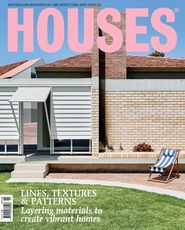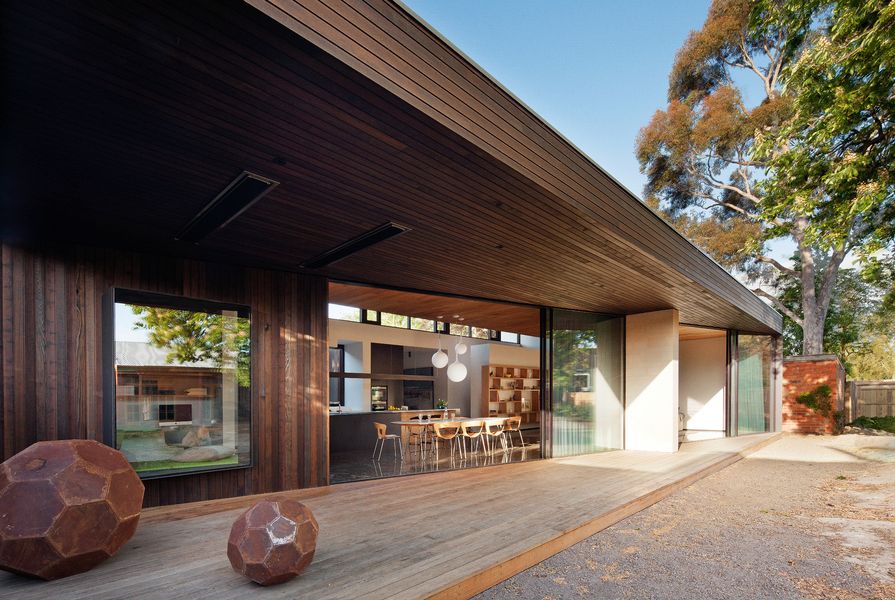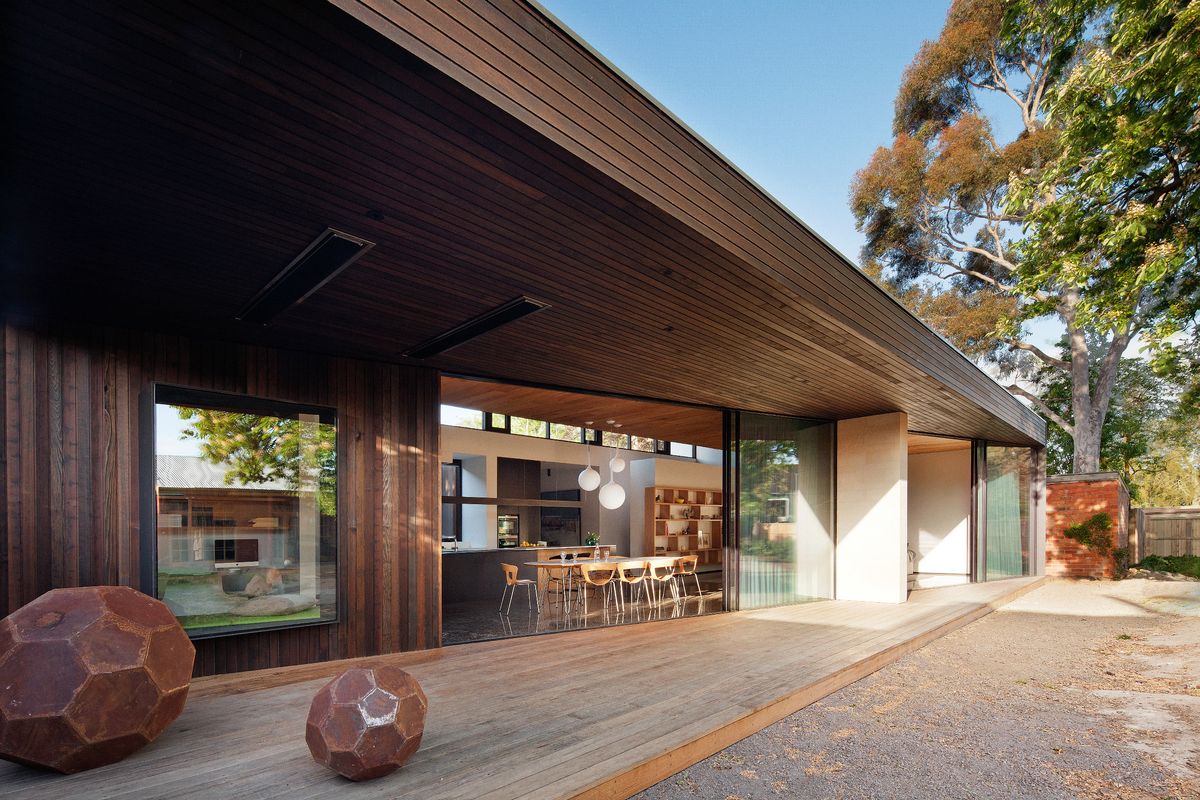Ballarat is heritage-heavy. The Victorian city boomed into life with the gold rush in the 1850s and rapidly built a hefty stock of architectural piles. Along Webster Street, the houses are generous in scale – less the houses of goldminers than of goldmine owners. Protected by heritage regulations, these dwellings are unlikely ever to be demolished, but the rear additions ebb and flow with the latest fashions and lifestyle changes.
The informal entry is located next to the garage, the dark timber and black steel creating a protected doorway that leads into the living area.
Image: Shannon McGrath
The Ballarat House by Moloney Architects is an alteration and addition to a late-nineteenth-century home. The old house acts like a prelude, setting the tone and mood for the overture that is Moloney Architects’ rear addition. There is a new front door, an informal entry, where you walk down the side of the house and go straight into the new open-planned living/lounge/kitchen, but the formal entry sequence introduces the architects’ new design moves in pieces, an experience that builds to a carefully orchestrated crescendo. “With the extension, we felt we had to match the level of grandeur of the existing house,” explains Mick Moloney, co-founder of the practice along with Jules Moloney.
The scale of the original interior is remarkable. Classical plaster decoration, four-metre-high ceilings, a fine art collection and plush carpeted floors contribute to a museum-like atmosphere (aided on the day I visit by the fact that the clients’ four young children are playing in the extension, not here). The first subtle piece of contemporary addition is a pair of timber bookshelves, one either side of a fireplace. They don’t touch the floor, as if to suggest that contemporary design has overcome the constraints of gravity. The weightless act is leveraging the solidity of the old house’s masonry structure.
The extension’s roof is pitched up toward the north to allow ample daylight into the space. Artwork: Adam Nudelman.
Image: Shannon McGrath
Honey-coloured wood unfolds as a motif, a sign of the new. It appears where changes have been made to the existing architecture, around new door openings and lowered ceilings. Black steel plate performs a similar function on the exterior, surrounding new window openings that have been inserted into the old brickwork. Mick cites a love of Italian architecture in general, and the work of Carlo Scarpa in particular. Scarpa was famous for his blending of contemporary design with historical contexts, always making the two identifiable and distinct. Only one new window in the extension was designed to look like an old one, a decision made with the local council’s heritage consultant, to create a balanced pair within a bedroom wall. Skylights in new bathrooms cut right up into the pitch of the existing roof, hiding the light source. As in a niche in a baroque cathedral, the light spills down and illuminates – in this case not a statue – regular grids of ordinary ceramic tiles, revealing their texture in a play of light and shadow.
Glimpses of the big, new timber-clad box appear from within the old house. In finely crafted timber, it looks like more joinery that has escaped and been enlarged to become habitable architecture. The addition is separated with a glazed link, politely but not exactly humbly. Existing ceiling heights are matched, and the feeling of light and spaciousness exceeded. It isn’t a straight box. The southern glazed wall cuts inside on a diagonal line, producing a variation in cosiness level between the two ends of the new living space: study nook at one end, lounge at the other. The roof and floor carry on to complete the box, the leftover covered outdoor space becoming a deck area.
A view from the light-filled extension showing the study and kitchen, looking down the glazed linkway toward the existing dwelling.
Image: Shannon McGrath
The most interesting moment in the design journey for me was halfway in, at the kids’ bedrooms in the rear of the old house. The line between heritage and contemporary elements is ambiguous here, in a way that is controlled carefully by the architect. Optical tricks confuse the eye: How thick are the walls? Is that new or existing? Lightweight partition walls have returns, clever corner details that give the impression of great thickness, of substantiality, in tune with the existing mansion. “You never see a ninety-millimetre stud wall end in the house,” says Mick. The intense level of detail in the design of the storage cupboards-cum-window seats is delightful.
In the twenty-first century, Ballarat is experiencing significant population growth, caused in part by people moving out of Melbourne’s increasingly unaffordable property market. For one hundred and fifty years Ballarat stayed more or less inert and, though changing, today remains a conservative place. Mick moved to Ballarat from Melbourne in 2007, and could be seen as part of the “new” Ballarat. “It helps that my wife is from Ballarat,” he says.
Most of Moloney Architects’ jobs, this one included, have involved knocking down the accretions of the twentieth century. The Ballarat House extension certainly has a level of grandeur about it, but in timber it also seems less permanent than the existing dwelling and its setback would allow its easy disassembly should it be required. Not that this is what Mick had in mind. “The ideal would be that the addition would itself get heritage protection one day,” he says. Will it stand against the rise and fall of the tides of fashion? Only time will tell. For now, it’s best to savour and appreciate beauty while it’s there.
Products and materials
- Roofing
- Lysaght Custom Orb sheeting in Colorbond ‘Monument’; Knauf Earthwool insulation; Harper and Sandilands timber ceilings in ‘Smoked Oak’.
- External walls
- Cedar Sales cedar cladding finished in Cutek ‘Black Ash’; sandstone in ‘Mount White’ from Gosford Quarries.
- Internal walls
- Hard plaster painted in Dulux ‘Natural White’; Harper and Sandilands timber wall in ‘Smoked Oak’.
- Windows and doors
- Townsend Joinery cedar windows finished in Cutek ‘Black Ash’; custom-made steel window reveals designed by Moloney Architects coated in Dulux Ferrodor; large sliding doors from Schueco.
- Flooring
- Harper and Sandilands American oak boards in ‘Smoked Oak’; polished concrete with black oxide in concrete, exposed bluestone and quartz aggregate.
- Lighting
- Euroluce Sunny Lights; Darkon Architectural Lighting CDN Siege track lighting; Artemide Castore pendants.
- Kitchen
- Schock sink in black reconstituted stone; Caesarstone benchtop in ‘Snow’; American oak timber veneer and stained in black.
- Bathroom
- Caroma mixers and basin; Abey mixer; Apaiser stone bath; Ram Tapware outlet.
- Heating and cooling
- Bosch in-slab hydronic heating; airconditioner recycled from existing house.
- External elements
- Spotted gum decking in Cutek oil.
- Other
- Some furniture, including armchairs, stools, and desk chairs, selected by Beatrix Rowe Interior Design.
Credits
- Project
- Ballarat House
- Architect
- Moloney Architects
Ballarat, Vic, Australia
- Project Team
- Mick Moloney, Jules Moloney
- Consultants
-
Builder
Renovative
Engineer TGM Group
Joinery A. B. Nolan Joinery
- Site Details
-
Location
Ballarat,
Vic,
Australia
Site area 2500 m2
Building area 652 m2
- Project Details
-
Status
Built
Category Residential
Type Alts and adds, New houses
Source

Project
Published online: 7 Jul 2016
Words:
Tobias Horrocks
Images:
Shannon McGrath
Issue
Houses, April 2016


























